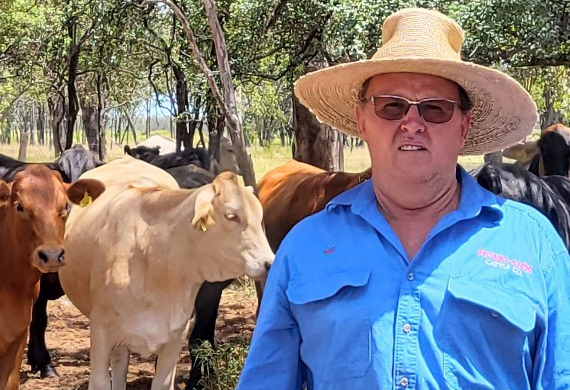 Reid Bauman
Reid Bauman
Key points:
- Separate breeders into groups based on their stage of production.
- Take your time to compare data.
- Don't be afraid change your management plan.
For Queensland beef producer Reid Bauman, years of fluctuating seasonal patterns made strong breeder performance and consistent calving rates a continuous struggle.
"We constantly swing between years of high and low rainfall, so I was keen to find a system which ensured my breeders were remaining productive throughout our drier years," Reid said.
The 'Girl Power' Producer Demonstration Site (PDS) caught his attention as an opportunity to get as many calves as he could during poorer pasture years, without having to increase breeder numbers.
Production cycle
According to Reid, Girl Power's goal wasn't to reprogram his production cycle, but rather to reinforce his decision making and lock in his key production dates.
"We aim to muster twice a year, so lining up other husbandry procedures with these events was the best action for us," Reid said.
"On 1 January, we put our bulls in with breeders and leave them in for 90 days, which often allows for a round of mustering to happen in March when we remove them.
"If it's a dry year, we'll often wean our previous years' calves when we're removing bulls after branding in February. However, if the season is looking good, then we will likely hold off on mustering until June.
"While we did attempt to include preg testing alongside weaning, it just wasn't manageable so our preg testing now occurs in July."
Supplementation
When it comes to his first-time breeders, Reid believes 95% maiden heifer conception should be a guarantee.
"Our breeders are at least two years old, have reached critical mating weight (CMW), and are fully vaccinated before we put them forward for their first joining," Reid said.
"If our girls are in the best condition they can be, then there shouldn't be any reason for them not to conceive."
To help achieve CMW, Reid implements rotational grazing and uses supplementation as a reserve should pastures become less productive during years of low rainfall.
"Supplementing is great when the quality of your pasture has declined but you still have a good overall quantity of feed sufficient for stocking rate," Reid said.
"If we don't get enough rain during our annual joining period, we'll look to bring out lick and phosphorus supplement, especially for our heifers.
"We don't have the data to back it up yet, but in previous years we've noticed supplementation gives our pregnant and lactating heifers the right nutrients they need during our tougher years to increase their likelihood of carrying to term and producing higher weight weaners."
Data Collection
Reid is an advocate for accurate data collection to improve breeder performance.
"While Girl Power is heifer-focused, I felt Bull Breeding Soundness Evaluations were critical for success in understanding and acting on production challenges," Reid said.
"Confirmation our bulls are virile, healthy and supporting good genetics has helped us rule them out as an issue when it comes to poor conception rates and calf loss."
After he's confirmed his bulls are in working order, Reid focuses on collecting data on his heifers.
He had already implemented a similar tagging system to the one suggested by the Girl Power facilitators, so his heifers were identifiable by year with coloured tags.
"We've been marking our breeders with different coloured ear tags to reflect the year they were first joined," Reid said.
"Prior to Girl Power, we would record data on pregnancy rates and foetal aging of each age group as a whole.
"However, during the project we switched to linking the data we record to our breeders' NLIS tags as opposed to their coloured age group tags.
"This meant instead of just seeing data reflecting the performance of the breeder age group, we were also getting data reflecting the performance of the individual heifer each year."
Reid also decided to use data to identify which breeders delivered a live calf.
"With our first-time breeders, we elected to keep them separate until they delivered their first live calf before integrating them into our breeder mob. However, we're also looking to more closely monitor whether or not our older breeders are continuously delivering live calves."
Reid sells breeders who fail to fall pregnant by the end of his joining period.
Recording data based on NLIS tags will now allow him to identify why failure to conceive or carry to term may occur, especially if they've fallen pregnant in previous years.
"The data is very new, but we're hoping in future years we might see trends which will help us pinpoint any common denominators within underperforming breeders, such as age or weight."






